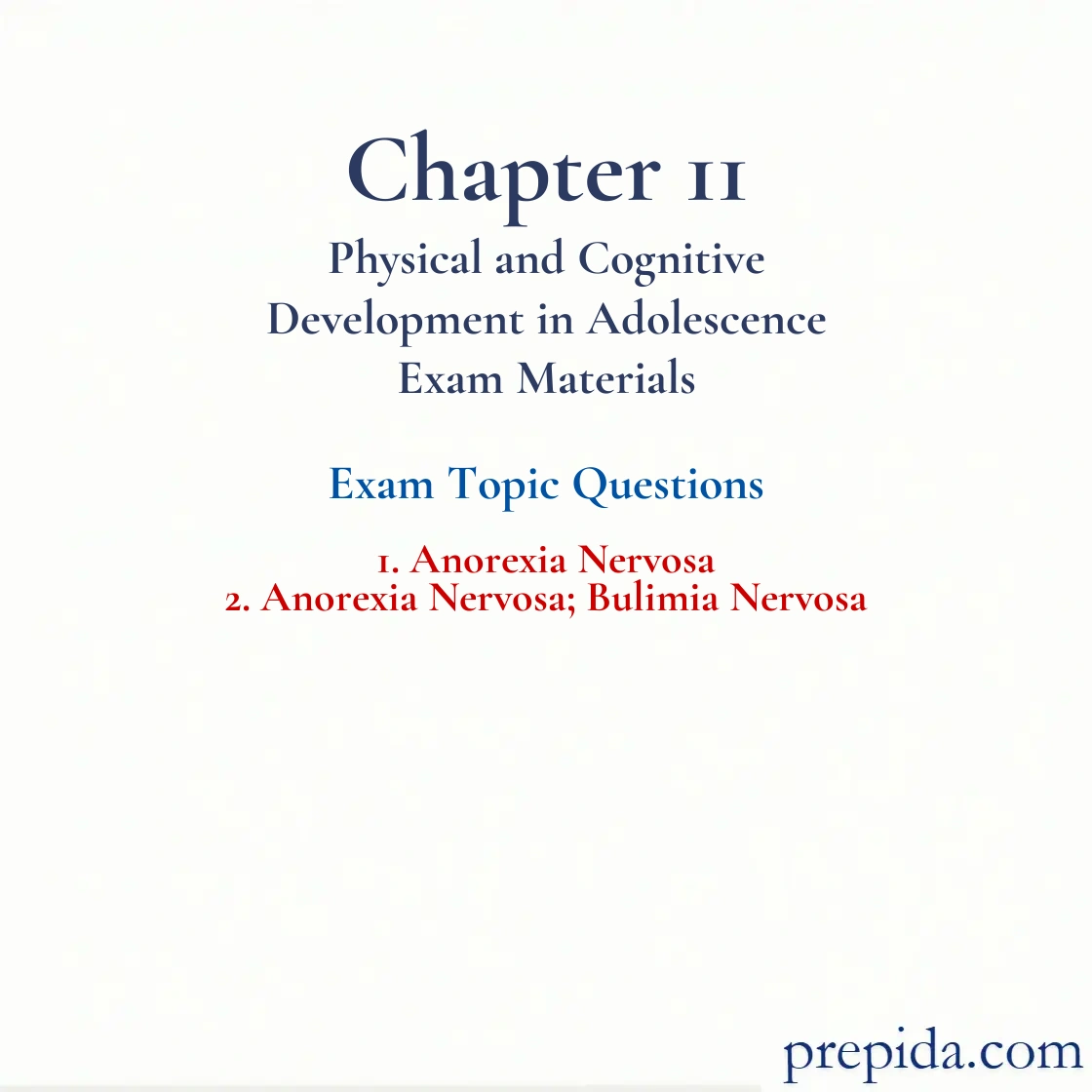
Based on the age of onset, when is anorexia nervosa most likely to begin?
- childhood
- late adulthood
- emerging adulthood
- early to middle adolescent years
Anorexia Nervosa: An eating disorder that involves the relentless pursuit of thinness through starvation.
Which of the following characterizes a person suffering from anorexia nervosa?
- a relentless pursuit of weight gain through binge eating
- a positive image of the body shape
- an intense fear of gaining weight that does not decrease with weight loss
- a high level of self-efficacy
Anorexia Nervosa: An eating disorder that involves the relentless pursuit of thinness through starvation.
Which of the following is one of the main characteristics of people suffering from anorexia nervosa?
- precocious puberty in girls
- amenorrhea in girls who have reached puberty
- body weight that falls in the 98th percentile of the BMI scale
- binge eating followed by purging
Anorexia Nervosa: An eating disorder that involves the relentless pursuit of thinness through starvation.
Which of the following is one of the main characteristics of people suffering from anorexia nervosa?
- higher than average body weight
- higher than average height
- a distorted image of their body shape
- a constant need to consume food
Amanda's mother suffers from anorexia nervosa. Which of the following statements about Amanda is most likely true?
- Amanda is highly likely to have a more positive body image.
- Amanda is at risk of developing anorexia nervosa herself.
- Amanda is more likely to have healthy eating habits.
- Amanda is not at risk for anorexia nervosa because of increased awareness.
________ refers to a lack of menstruation in girls who have reached puberty.
- Amenorrhea
- Anemia
- Menarche
- Anorexia
Menarche: A girl’s first menstruation.
Anorexia nervosa is a(n)
- eating disorder that involves a binge-and-purge sequence on a regular basis.
- anxiety disorder whose chief symptom is an unrealistic fear of food.
- drug-induced reaction that produces tremors and vomiting.
- eating disorder that involves the relentless pursuit of thinness through starvation.
Identify a true statement about anorexia nervosa.
- It is about 10 times more likely to occur in females than in males.
- It occurs when an individual consistently follows a binge-and-purge pattern.
- It is difficult to detect as anorexics fall within a normal weight range.
- It begins in late adolescence or early adulthood.
Most anorexic individuals are young adult females from
- middle- and upper-income families.
- poor and working-class families.
- Asian American and African American families.
- families with low achievement demands.
Socioeconomic Status (SES): Refers to the grouping of people with similar occupational, educational, and economic characteristics.
Anorexic people use food as a means of
- control.
- reward.
- punishment.
- gaining popularity.
Cognitive Control: Effective control of thinking in a number of areas, including controlling attention, reducing interfering thoughts, and being cognitively flexible.
Jackie, a 15-year-old girl, has been diagnosed with anorexia nervosa. It is most likely that Jackie
- sets very low standards for herself.
- is not very concerned about how others perceive her.
- is competitive and high-achieving.
- is an African American from a low-income family.
Identify a characteristic of persons suffering from anorexia nervosa.
- weight below 85 percent of what is considered normal for their age and height
- an intense fear of losing weight that does not decrease with weight gain
- unconcerned about how others perceive them
- consistently follow a binge-and-purge pattern
Katie weighs less than 85 percent of what is considered normal for her age and height. Yet, she sees herself as too fat and starves to become thinner. Katie most likely suffers from
- anorexia nervosa.
- bulimia nervosa.
- binge eating disorder.
- body dysmorphic disorder.
Which of the following is a dissimilarity between those diagnosed with anorexia nervosa and those suffering from bulimia nervosa?
- Anorexics have difficulty controlling their emotions, but bulimics do not.
- Anorexics fall within a normal weight range, but bulimics are underweight.
- Anorexics have a positive body image, but bulimics do not.
- Anorexics control their weight by restricting food intake, but most bulimics cannot.
Identify the similarity between those diagnosed with anorexia nervosa and those suffering from bulimia nervosa.
- They are unconcerned about their weight.
- They are severely underweight.
- They have a distorted body image.
- They maintain a healthy, well-balanced diet.
Martha is suffering from bulimia nervosa, whereas Jane has been diagnosed with anorexia nervosa. The difference between them is that Martha
- will eventually recover from the disorder.
- is likely to be highly perfectionistic.
- has an eating disorder.
- has her weight within a normal range.
Anorexia nervosa and bulimia nervosa affect
- men and women equally.
- men more than women.
- women more than men.
- women more than older men but less than younger men.
Unlike anorexics, individuals who have been diagnosed with bulimia nervosa typically
- have a positive body image.
- go on an eating binge and then purge.
- find it easier to restrict food intake.
- lack a fear of becoming overweight.
Bulimia Nervosa: An eating disorder in which the individual consistently follows a binge-and-purge pattern.